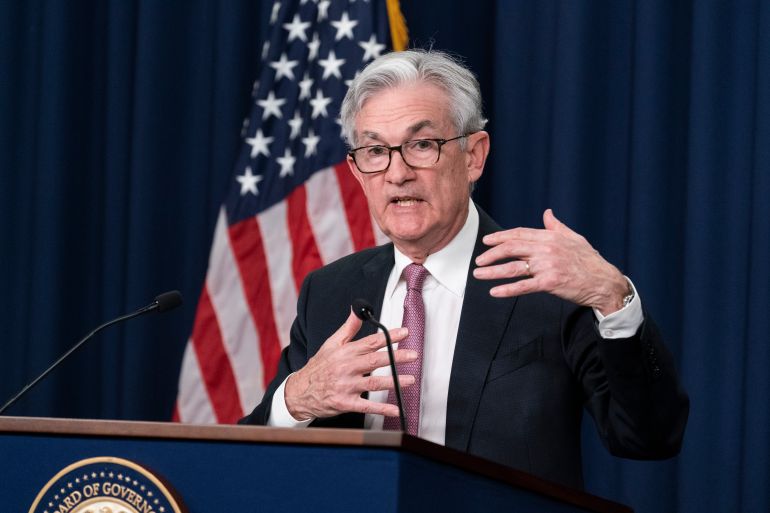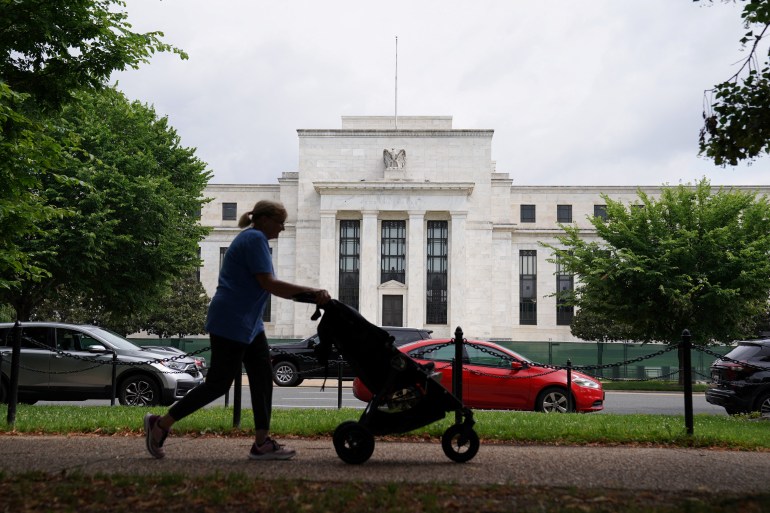US targets inflation with biggest rate hike since 1994
The move raises the short-term federal funds rate, meaning most forms of borrowing will become sharply more expensive.

The US Federal Reserve raised its target interest rate by three-quarters of a percentage point in an effort to drive down a surge in inflation, and projected a slowing economy and rising unemployment in the months to come.
The rate increase announced on Wednesday was the biggest by the US central bank since 1994, and was delivered after recent data showed little progress in its battle to control a sharp spike in prices.
Keep reading
list of 3 itemsRussia-Ukraine war threatens prolonged effect on global economy
China’s economy showed recovery sparks in May but consumers wary
The move raised the short-term federal funds rate to a range of 1.5 percent to 1.75 percent. With additional rate hikes, policymakers expect their key rate to reach a range of 3.25 percent to 3.5 percent by year’s end — the highest level since 2008 — meaning most forms of borrowing will become sharply more expensive.
“Inflation remains elevated, reflecting supply and demand imbalances related to the pandemic, higher energy prices and broader price pressures,” the central bank’s policy-setting Federal Open Market Committee said in a statement at the end of its latest two-day meeting in Washington. “The committee is strongly committed to returning inflation to its 2 percent objective.”

The move comes as inflation has shot to the top of voter concerns in the months before Congress’ midterm elections, souring the public’s view of the economy, weakening President Joe Biden’s approval ratings and raising the likelihood of Democratic losses in November.
Biden has sought to show he recognises the pain that inflation is causing American households but has struggled to find policy actions that might make a real difference. The president has stressed his belief that the power to curb inflation rests mainly with the Fed.
The move also comes as the central bank is ramping up its drive to tighten credit and slow growth with inflation having reached a four-decade high of 8.6 percent, spreading to more areas of the economy and showing no sign of slowing.
Meanwhile, Americans are starting to expect high inflation to last longer than they had before. This sentiment could embed an inflationary psychology in the economy that would make it harder to bring inflation back to the Fed’s 2 percent target.

The Fed’s three-quarter-point rate increase exceeds the half-point hike that Chair Jerome Powell had previously suggested was likely to be announced this week. The Fed’s decision to impose a rate increase as large as it did was an acknowledgement that it is struggling to curb the pace and persistence of inflation, which has been worsened by Russia’s war against Ukraine and its effects on energy prices.
Asked at a news conference on Wednesday why the Fed was announcing a more aggressive rate increase than he earlier signalled, Powell replied the latest reports had shown inflation to be hotter than expected.
“We thought strong action was warranted at this meeting,” he said, “and we delivered that.”
Even if a recession can be avoided, economists have said it is almost inevitable that the Fed will have to inflict some pain — most likely in the form of higher unemployment — as the price of defeating chronically high inflation.
During the next two years, officials are forecasting a much weaker economy than was envisioned in March. They expect the unemployment rate to reach 3.7 percent by year’s end and 3.9 percent by the end of 2023.
Those are only slight increases from the current 3.6 percent jobless rate. But they mark the first time since it began raising rates that the Fed has acknowledged its actions will weaken the economy.